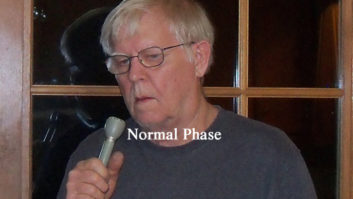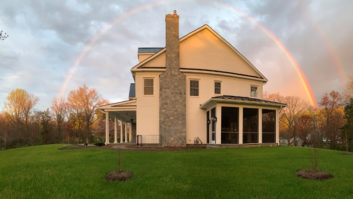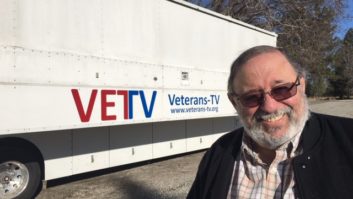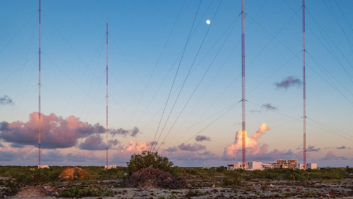Preparing for the gold
Feb 1, 2006 12:00 PM, By Conrad Trautmann, CPBE
For two weeks in February, Torino, Italy, is the center of winter sports activity. Westwood One, the radio rights holder for the United States, began planning for this year’s coverage during the 2004 Summer Olympics in Athens. While on-site in Greece, we kept a running list of things we wanted to upgrade or change. That list grew to be three pages long. It became an essential guideline for the planning and budgeting process that commenced when we returned from Athens.
Site surveys were completed in November.
Studio A begins to take shape as the equipment is installed.
The transmission racks are connected.
Edit position three is wired and ready to go.
The final touches are made to control room A.
The transmission racks set into place and partially interconnected.
The final checks on the transmission and IT racks are complete.
Bullpen position 1 is ready to go.
Edit positions 1, 2 and 3 are set up and ready.
We kept the remote kit together and duplicated most of the Athens setup because there was only about a year between the time the equipment returned to the United States and the time staging needed to begin for Torino. In the interim, we stored the equipment off-site so it wouldn’t be touched or picked through for other projects. We needed to purchase a few more computers for Torino, but we will re-deploy all of the computers used in Torino throughout Westwood One once they return because by the summer Olympics in 2008 they will surely be obsolete.
During the summer months of 2005 we ordered the equipment that we would need. This included an expansion to the SAS 32KD router from a 64�64 system to a 96�96 system. In Athens, we filled the router and discovered that there were sources that we had not planned for. Most of this added capacity was used for a full effects feed from every venue. Athens was the first time that we had such a feed for every venue since we have covered the Olympics. Previously, we would take the effects feed from a TV feed or simply leave a microphone open courtside. The difference now is that the host broadcaster has a full effects feed. The swish of a skier flying down a hill will be much clearer during the coverage. All of those additional feeds needed extra inputs on the router. In addition, we’ve expanded our coverage in Torino by adding a radio row. Each of our affiliates now has a dedicated output of the router for its own use.
High regard for quality
Once again, all the audio is produced uncompressed and transmitted to the United States using digital linear audio cards over a T-1 circuit. We purchased new T-1 equipment from Harris Intraplex and are using PT-350 cards for transmission. We purchased Edirol R-1 digital recorders for our reporters to use for interviews, which record WAV files. In Athens, our producers and editors appreciated the speed at which they could transfer a file from a digital recorder to a computer for editing. In the past, they would roll an interview into the computer in real time from DAT or Minidisk. Now it’s simply a drag-and-drop procedure. It also improved the quality of our coverage, because we can get to air much faster with interview audio.
As mentioned earlier, our coverage has expanded in Torino with the addition of radio row, in which we host affiliate radio stations on-site at the International Broadcast Center (IBC). We’re hosting stations from New York, Los Angeles, Detroit and Washington, among others. Like our setup at the Grammys or the Final Four, we provide a full remote setup for each affiliate, which includes a mixer, two microphones, headphones and a computer. The computer has Internet access and a soft-panel that controls an output of the SAS router. This gives each affiliate access to any source on our router. Plus, it has editing software so the affiliate can edit our audio or its own for playback through the mixer. We also provide transmission to and from New York over the T-1. In the United States, a station can dial into a dedicated ISDN codec in New York to retrieve the audio directly for that station.
We built three control rooms and one studio in Torino. One control room is dedicated to our around-the-clock short-form coverage. The second, identical control room acts as an emergency backup to the first and is used for production of the play-by-play coverage of hockey. The last control room is paired with a studio for our long-form daily wrap-up show and any miscellaneous production. The control rooms use Logitek Roc 10 consoles, which have been serving us well since they were purchased for our coverage of the 2000 Summer Olympics in Sydney, Australia.
This is the second Olympics for our Enco Dad Pro 32 system. Its debut was in Athens. Being able to load all of our formats in advance, have commercials instantly flow into a schedule and being able to make changes on the fly really added to the efficiency of the production over previous Olympics. The Westwood One commercial traffic system produces an ASCII text file of our log and Enco engineers wrote a routine that allows the log to be imported into the system. The Enco is programmed for each of our three program streams (long-form, short-form and play-by-play) and automated to turn the faders on and off on the audio console and start our sounders at the exact times needed. We synchronize the computer clocks to SMPTE time code from a GPS master clock. Because we are synchronized on time, we set the formats to start the broadcasts exactly on time. It takes control for the announcers, especially on the short-form reports. They don’t need to worry about pushing anything except the button to start the commercial at the end of their reports.
First-hand survey
On Nov. 11 and Nov. 12, 2005, Westwood One Vice President of Sports Chris Castleberry and I visited Torino to survey the site of the IBC and the venue sites. That gave us an opportunity to work out any last-minute logistical details prior to shipping our equipment. We spent two days in Torino, the first day visiting the event venues located in the city of Torino and the second visiting the mountain venues.
The city hosts most of the indoor venues, such as the main Olympics Stadium, ice hockey and speed skating. This is where the IBC is located. The IBC is one of the most exciting places to be if you’re in the media, because this is literally the hub of all feeds for the Olympics TV and radio coverage to all countries. Walking down the main hallway in the IBC, you pass the broadcast facilities of every major broadcaster in the world. At the IBC, all of the venue feeds are brought back to a main distribution point. From there, the feeds are run through distribution amplifiers and are handed off to the various media organizations. We visited our space in the IBC to make sure that the rooms were built as we specified and to measure the space to make sure our equipment would fit.
During our visits to all the venues we checked the broadcast location. In most cases, we could stand in the spot where our crew will be during the games, which enables us to see the vantage point of the event. This is important for our announcers so we know how they will be able to view the actual events for live coverage purposes. We look for an unobstructed view. We also check access to the broadcast location. In some cases, we may have one announcer covering multiple venues, so access in and out can be important with regard to the timing of getting from one place to another. Also, we check the transportation logistics to make sure our staff knows how to get around. Some of the mountain venues, for instance, are not served by coach buses because of the tight turns in the roads leading up the mountainside. Crews need to transfer from the coach bus to a smaller shuttle to get to where they’re going. The mountain venues are at least a one-hour trip west of Torino; a little longer to the farthest venue.
Taking inventory
Our equipment uses 137 road cases and was shipped Dec. 9 for delivery on site to the IBC at the beginning of January. Our engineering team arrived on site Jan. 16 for its 45-day trip. The first two weeks were our setup time to build the studios, run the wires and turn everything on. During the third and fourth week the production staff arrived and learned how to use everything as it began preparation for the opening ceremonies. And then we’re live for just over two full weeks. We found our breakdown takes one full day with four people packing.
Set up at the IBC during the first two weeks is made easier by prewiring all the equipment before it leaves New York. Almost everything remains in the road cases once it arrives on site, which makes direct wiring of the equipment in New York possible. Once on site, cables run from the studios back to the transmission room. We used multipair CAT-5 that breaks out to an RJ45 panel in each room and multipair audio cable to Amphenol connectors for the audio runs. The transmission room is located in a room adjacent to our studios in the IBC. Our design approach is to build the space as if it were a radio station. Four studios and the edit workstations all come back to the transmission room via home runs. All of the venues are also brought back to the transmission rooms via four-wire circuits. The host broadcaster manages everything from the venue to the IBC. Each venue has a mixer and headphones that are controlled on site by a technician dedicated to the facility. From there it is sent over the four-wire circuit to us. We transmit a mix minus with IFB from the IBC to the talent, and that is selectable depending on which studio or editor has the program live at that time.
Everything runs in and out of the router that also serves as the intercom system. The main program outputs feed the T-1 equipment to New York. We have metering and monitors across the outputs for a final assurance that we are actually transmitting. Symetrix 425s are placed inline as a final limiter in the chain before it hits the T-1; No processing, just limiting to prevent overshoot and distortion on the line.
Finally, a “barker” is put on the transmission paths from the IBC. It appears as a source on the router that is fed with a consumer MP3 player set to loop. It was the least expensive alternative.
Trautmann is senior vice president of engineering for Westwood One, New York.
Equipment List
Dell computers
Dixon NM250-MKII
Edirol R-1
Enco Dad Pro 32
Genelec 8020
Harris Intraplex STL Plus
Fostex 6301B
Logitek Roc 10 and Audio Engine
Marantz PMD660
Metrosource software
Rhode NT2
SAS 32KD
Shure SM58
Symetrix 425, 528E
Telos Xstream
Timeline
Planning for the Olympic broadcast begins several months in advance.
6-1-2005Equipment list finalized and budget approved during month of June. 7-1-2005Equipment ordered. This provides an eight-week window to get everything to NY in time for staging. 8-29-2005Equipment in NJ storage unit is transferred to NY Broadcast Center for staging. This provides 11 weeks to set up and test everything prior to shipping. 10-15-2005Operations/engineering meeting in NY to review all details of broadcast. 12-4-2005Equipment loaded and shipped to Torino. Shipping normally takes six weeks, but nine weeks are to allow for the three holidays: Thanksgiving, Christmas/Hannukah and New Year’s. 1-16-2006Tech team arrives on site to begin installation. This allows the same amount of time before of opening ceremony that was allotted in Athens, which was perfectly timed. 2-10-2006Opening ceremony.









